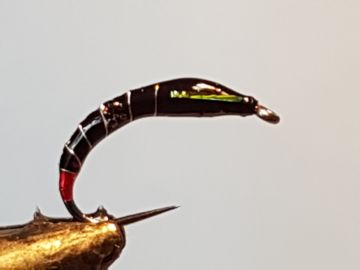Nymphs
{{start}}
The word nymph has of course two fly fishing meanings. The first is “Juvenile, sexually immature stage of certain insects, usually similar to the adult in form, and which require an intermediate stage before becoming an adult. Mayflies, Caddis flies, Dragonflies, Damselflies, Stone flies and Midges are all insects that spend part of their life cycle in the water and have a nymph stage.” The second which is flies tied to the first i.e. “the nymphal stage of an insects life cycle.I have narrowed down the selection of nymphs that I carry to the list below’.
{{end}}

{{+1}}Epoxy midge – black with hot butt & UV cheeks{{-1}}
{{start}}
When Chironomids are around they tend to be around in large numbers and trout become quickly switched on and gorge on them. There are number of techniques to target chironomid feeders and one of my favourite is to fish three chironomid imitations with the heaviest on the point with a long leader on a floating line and fish relatively static. You will be surprised how many fish find your flies.{{end}}

{{+1}}Muskins PTN{{-1}}
{{start}}
This is very popular Northern hemisphere fly and whist it more popular in still water it also has its uses in running water. Appealing to fish that are on mixed diet that includes mayfly nymph and midge.{{end}}

{{+1}}UV cruncher{{-1}}
{{start}}
More of a class of fly than a fly in itself because you will find UV crunchers tied a all sorts of colours from black right through to dun colours and pale olives. I like this particular tie because it incorporates peacock herl which is one of my favourite fly tying materials.{{end}}

{{+1}}PTN variant{{-1}}
{{start}}
This variation of Frank Sawyers pheasant Tail Nymph takes into account the shorter herl on pheasant tails that dominate the market these days and to include the substitution of peacock or coloured dubbing in the thorax and the addition of legs.{{end}}

{{+1}}Black Spectra nymph{{-1}}
{{start}}
I also tie it with a little added weight because if river water is a little dirty its often running a little stronger as well and I always reckon it best to get your fly down to where the fish are holding. The weight is also useful if you use this fly on the point of your loch fly team as it does help the leader to stay straight and decreases the incidence of loose line.{{end}}

{{+1}}Chatto’s “inch” nymph{{-1}}
{{start}}
This fly has been designed with polaroiding in mind. Its also a great fly for covering rising fish ... particularly if mayfly are around. It's unlike all the other nymphs that I tie in that it is tied with as little extra weight as possible. As a result it hits the water softly and once there sinks slowly in a realistic way giving the target fish plenty of time to see the fly and hopefully eat it.{{end}}

{{+1}}Gold ribbed hares ear{{-1}}
{{start}}
This is probably up there in the top 3 or 4 best known nymph patterns. It's a pattern that has stood the test of time and is suggestive of a wide range of caddis and mayfly nymphs and is best fished close to the bottom. It doesn't matter if your in Argentina or Australia or any where between, past, above or below this is a true universal fly pattern.{{end}}

{{+1}}Zug bug – Chatto’s version{{-1}}
{{start}}
This fly has stood the test of time being designed in the 1930's as a cased caddis imitation in the Catskills by Cliff Zug. It continues to be relevant today on any water where caddis are on the menu. It is equally at home in rivers and lakes. It's no surprise that the body is peacock herl a material that has made flies like the diawl back and prince nymph amongst the top fish taking flies.{{end}}

{{+1}}Zug bug jig – Chatto’s version{{-1}}
{{start}}
This fly has stood the test of time being designed in the 1930?s as a cased caddis imitation in the Catskills by Cliff Zug. This jig version is particularly good for running water as the shape of the jig hook causes the leader to partially invert the fly mitigating snags as the fly bounces along the bottom.{{end}}

{{+1}}Tarlington’s Corduliid (aka TC){{-1}}
{{start}}
I have fond memories of this fly from my early days of fly fishing. One of my favourite destinations was 'Frying Pan' which is the closest lake Eucumbene destination to Cooma where the TC was designed by Cooma resident Frank Tarlington. On one of those memorable trips to 'Frying Pan' I was introduced to one of the 'gun' regular fly fishers named Stan. When the mudeyes were on Stan would forgo all other flies and stick to a fly that he absolute confidence in , the TC. I have had a lot of respect for that fly ever since.{{end}}













